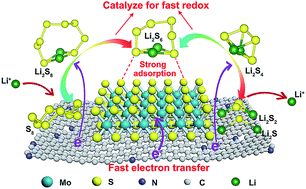Enabling immobilization and conversion of polysulfides through a nitrogen-doped carbon nanotubes/ultrathin MoS2 nanosheet core–shell architecture for lithium–sulfur batteries†
Abstract
Lithium–sulfur batteries are widely considered as promising next generation energy storage devices due to their high energy density and low cost. However, the shuttle effect and sluggish kinetics of polysulfide conversion are still key challenges for practical application. Herein, we designed hierarchical nitrogen-doped carbon nanotubes/ultrathin molybdenum disulfide nanosheets in a core–shell architecture (denoted as NC@MoS2) to alleviate the shuttle effect and propel redox reaction kinetics, thereby improving the electrochemical performance of lithium–sulfur batteries. Both experimental investigations and theoretical studies reveal that MoS2 nanosheets can chemically immobilize lithium polysulfides and catalyze the conversion of polysulfides. Moreover, this unique core–shell architecture could facilitate rapid electrical transport and favorable electrolyte infiltration. We have demonstrated that the obtained S–NC@MoS2 cathodes exhibit excellent rate capability (516 mA h g−1 at 5C) and superior cycle stability (only 0.049% capacity decay per cycle up to 1000 cycles at 2C). Remarkably, the composite cathode with a high sulfur loading of 3.6 mg cm−2 still maintains high rate capability and stable cycling performance over 300 cycles. This work offers a new strategy to develop high-performance lithium–sulfur batteries through the exploration of two-dimensional mediator catalysts.

- This article is part of the themed collection: 2019 Journal of Materials Chemistry A HOT Papers


 Please wait while we load your content...
Please wait while we load your content...